While Process Theory and Nolan’s Stages of Growth approach the study of technology in organizations from different angles, there are several similarities between them that reflect their shared interest in how technology evolves within an organizational context:
1. Dynamic Nature of Technology Adoption:
- Process Theory: Focuses on the dynamic, often unpredictable journey of technology adoption, integration, and adaptation within an organization. It considers the unfolding of events and how these lead to change.
- Nolan’s Stages of Growth: Similarly, this model describes technology adoption as progressing through stages, from initiation to maturity. Each stage represents a dynamic shift in how technology is perceived, used, and integrated into the organization’s operations.
2. Emphasis on Change Over Time:
- Process Theory: Is inherently about how change happens over time, focusing on the sequence of events and interactions.
- Nolan’s Stages: Explicitly models change through a series of sequential stages, suggesting that organizational use of IT follows a predictable pattern of growth and evolution.
3. Contextual Understanding:
- Process Theory: Recognizes that the impact of technology is highly contextual, shaped by the organization’s culture, structure, and existing processes.
- Nolan’s Stages: Although more structured, it also acknowledges that the progression through stages can vary based on the organization’s characteristics, leadership, and external environment.
4. Non-linearity and Feedback:
- Process Theory: Often highlights non-linear paths where feedback loops might cause revisiting or rethinking earlier stages or decisions.
- Nolan’s Stages: While presented linearly, Nolan recognized that organizations might experience feedback loops or need to revisit earlier stages, especially during crises or major shifts in technology or strategy.
5. Adaptation and Learning:
- Process Theory: Emphasizes learning and adaptation as key components of technology integration, where organizations learn from their experiences.
- Nolan’s Stages: The later stages, particularly ‘Maturity’ and ‘Data Administration’, focus on organizational learning, fine-tuning, and adapting to new technological paradigms or capabilities.
6. Influence of Human Elements:
- Process Theory: Considers human behavior, resistance, acceptance, and innovation as critical factors in how technology affects an organization.
- Nolan’s Stages: Human factors are implicit in the model, especially in terms of how management and staff adapt to each stage’s challenges and opportunities.
7. Evolutionary Perspective:
- Both theories view technology adoption not as a one-time event but as an ongoing process of growth, with each step building on the last, influenced by both internal dynamics and external pressures.
8. Strategic Implications:
- Process Theory: Provides insights into how to strategically manage technology change, focusing on the process itself rather than just the end goal.
- Nolan’s Stages: Offers a strategic roadmap for managing IT growth, helping organizations anticipate and prepare for future stages of technology integration.
In summary, both Process Theory and Nolan’s Stages of Growth acknowledge the complexity and evolutionary nature of technology within organizations. They both emphasize that technology adoption is a journey with stages, feedback, and the necessity for ongoing adaptation. These similarities make them complementary in understanding the broader narrative of technological change in organizational settings.










Leave a Reply